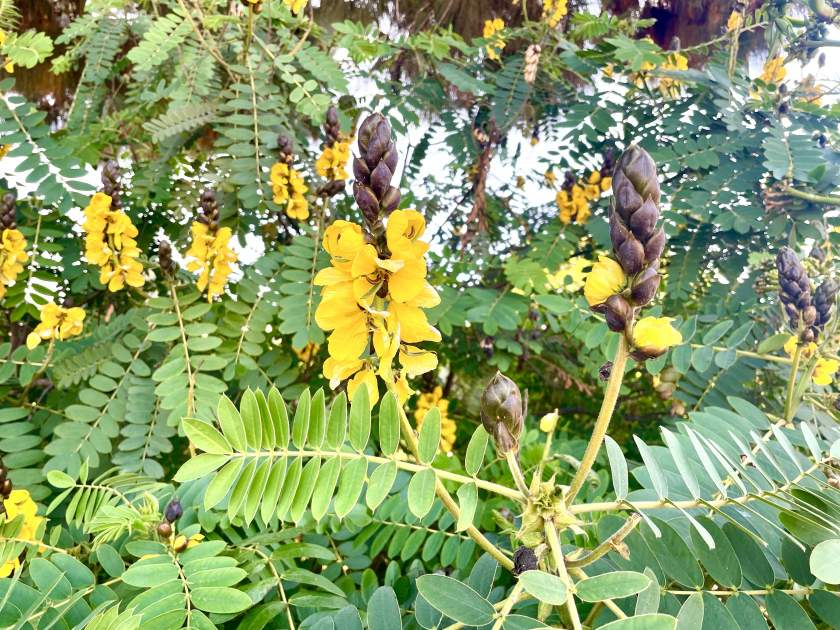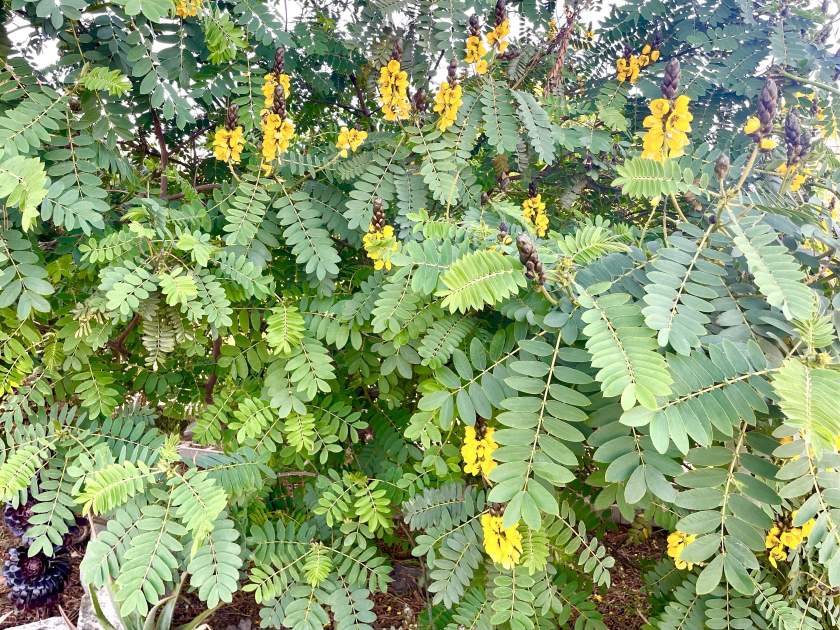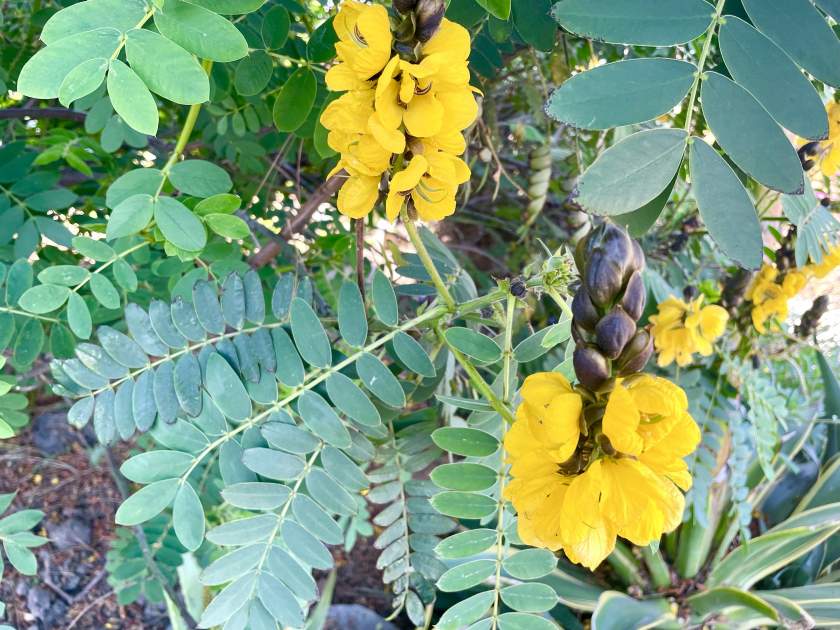Discover the Fascinating Senna didymobotrya: Aromatic Delights and Medicinal Wonders
Senna didymobotrya, commonly known as African senna, Popcorn Senna, Candelabra Tree, or Peanut Butter Cassia, is a remarkable flowering plant belonging to the Fabaceae (Leguminosae) family. This tropical beauty originates from Africa, where it thrives in diverse habitats across the continent. With its striking appearance, distinct fragrance, and medicinal properties, Senna didymobotrya has become a beloved choice among plant enthusiasts.
Characteristics: Leaves and Flowers
The African senna plant is a hairy, semi-deciduous shrub that can reach an impressive height of up to five meters (16 feet) under optimal growing conditions, occasionally reaching nine meters (30 feet). Its elongated oval leaves, measuring up to half a meter (1.6 feet) in length, consist of numerous pairs of leaflets. Each leaflet can grow up to 6.5 centimeters (2.6 inches) long, showcasing a vibrant green color.
Adding to its allure, Senna didymobotrya emits a strong and distinctive scent. Descriptions of its fragrance vary, with some likening it to the aroma of mice, wet dogs, peanut butter, or burnt popcorn. This unique scent further contributes to the plant’s overall charm.
The plant blooms abundantly, displaying racemes of bright yellow flowers. Some flowers may also appear in the leaf axils. The raceme features open flowers at the bottom, while unopened buds covered in brownish-green or black bracts adorn the tip. Each flower boasts five concave petals, ranging from 1.5 to nearly 3 centimeters (0.6 to 1.2 inches) in length. With ten stamens, typically seven fertile and three sterile staminodes, the flower showcases large anthers measuring approximately a centimeter (0.4 inches) long.
Following the flowering period, Senna didymobotrya produces flat brown legume pods, reaching up to 12 centimeters (4.7 inches) in length. Each pod contains as many as 16 bean-like seeds, with individual seeds measuring up to a centimeter (0.4 inches) long.
Cultivation: Nurturing Senna didymobotrya:
When cultivating Senna didymobotrya, providing appropriate care is vital for its well-being and optimal growth. Here are key factors to consider:
Sunlight: Senna didymobotrya thrives in full sun. Ensure the plant receives at least six hours of direct sunlight each day. In hotter climates, providing partial shade during the intense afternoon hours can protect the plant from excessive heat.
Watering: Maintaining adequate moisture levels is crucial for Senna didymobotrya. Water the plant deeply, allowing the soil to dry out slightly between waterings. Avoid overwatering, as it can lead to root rot. However, be mindful not to let the soil dry out completely, as this can cause stress to the plant. Regularly monitor the soil’s moisture levels and adjust your watering routine accordingly.
Soil: Senna didymobotrya prefers well-draining soil with a neutral pH level ranging from 6.6 to 7.5. A sandy loam soil composition is ideal for this plant. Ensure the soil is fertile, rich in organic matter, and capable of retaining moisture without becoming waterlogged. Amending the soil with compost or well-rotted manure can enhance its nutrient content and drainage properties.
Pest and Disease Management: Remarkably, Senna didymobotrya is generally resistant to pests and diseases. However, occasional infestations of mealybugs and scale insects may occur. Monitor the plant regularly for any signs of pests and promptly address the issue. Utilize organic pest control methods, such as insecticidal soap or neem oil, to treat infestations if necessary.
Propagation: Seeds and Cuttings
Senna didymobotrya can be propagated through seeds or cuttings. If using seeds, pre-treatment is necessary to soften the hard seed coat and promote water absorption. One effective method involves soaking the seeds briefly in nearly boiling water, followed by a 12 to 24-hour soak in warm water. Another technique involves gently abrading a small area of the seed coat without damaging the embryo. Treated seeds typically exhibit a higher germination rate compared to untreated seeds.
Cuttings, however, are generally less successful in propagating Senna didymobotrya. It is advisable to focus primarily on seed propagation for consistent and reliable results.

Medicinal and Wildlife Uses
Beyond its aesthetic appeal, Senna didymobotrya holds medicinal properties that have been valued within its native range, particularly in East Africa. The leaves stems, and roots of the plant possess laxative and purgative qualities. However, caution must be exercised when using this plant, as higher doses can be toxic.
Active compounds found in Senna didymobotrya include anthraquinone derivatives, tannins, and flavonoids. These compounds contribute to the plant’s laxative effects by stimulating peristalsis and inhibiting ion transport across colon cells. Additionally, Senna didymobotrya exhibits diuretic, vasorelaxant, antioxidant, antibacterial, and antifungal properties.
Traditionally, various preparations of Senna didymobotrya have been used to treat abdominal pains, expel intestinal worms, and address ringworm. Additionally, it has been employed to treat abscesses of the skeletal muscles, venereal diseases, fungal and bacterial infections, hypertension, hemorrhoids, sickle cell anemia, and a range of women’s diseases. The plant has also been utilized to stimulate lactation, induce uterine contractions, and aid in abortion.
Moreover, Senna didymobotrya attracts butterflies, insects, and nectar-feeding birds, enhancing biodiversity and promoting pollination within its ecosystem.
Unveiling Nature’s Marvel
Senna didymobotrya, with its striking appearance, distinct fragrance, and medicinal wonders, stands as a testament to the marvels of the natural world. Native to Africa, this versatile plant enchants with its vibrant flowers, impressive height, and intriguing scent. Cultivating Senna didymobotrya provides an opportunity to witness the beauty of nature firsthand while exploring its potential medicinal uses. With proper care and attention, this remarkable plant can flourish and captivate both gardeners and nature enthusiasts alike.





